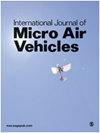Hear-and-avoid for unmanned air vehicles using convolutional neural networks
IF 1.5
4区 工程技术
Q2 ENGINEERING, AEROSPACE
引用次数: 2
Abstract
To investigate how an unmanned air vehicle can detect manned aircraft with a single microphone, an audio data set is created in which unmanned air vehicle ego-sound and recorded aircraft sound are mixed together. A convolutional neural network is used to perform air traffic detection. Due to restrictions on flying unmanned air vehicles close to aircraft, the data set has to be artificially produced, so the unmanned air vehicle sound is captured separately from the aircraft sound. They are then mixed with unmanned air vehicle recordings, during which labels are given indicating whether the mixed recording contains aircraft audio or not. The model is a convolutional neural network that uses the features Mel frequency cepstral coefficient, spectrogram or Mel spectrogram as input. For each feature, the effect of unmanned air vehicle/aircraft amplitude ratio, the type of labeling, the window length and the addition of third party aircraft sound database recordings are explored. The results show that the best performance is achieved using the Mel spectrogram feature. The performance increases when the unmanned air vehicle/aircraft amplitude ratio is decreased, when the time window is increased or when the data set is extended with aircraft audio recordings from a third party sound database. Although the currently presented approach has a number of false positives and false negatives that is still too high for real-world application, this study indicates multiple paths forward that can lead to an interesting performance. Finally, the data set is provided as open access.使用卷积神经网络的无人飞行器听和避
为了研究无人驾驶飞行器如何用单个麦克风检测载人飞机,创建了一个音频数据集,将无人驾驶飞行器的自我声音和记录的飞机声音混合在一起。卷积神经网络用于执行空中交通检测。由于无人驾驶飞行器在飞机附近飞行的限制,数据集必须人工生成,因此无人驾驶飞行器的声音与飞机的声音是分开捕获的。然后将它们与无人驾驶飞行器的录音混合,在此过程中,会给出标签,指示混合录音是否包含飞机音频。该模型是一个卷积神经网络,使用特征梅尔频率倒谱系数、频谱图或梅尔频谱图作为输入。对于每个特征,探讨了无人飞行器/飞机振幅比、标签类型、窗口长度和添加第三方飞机声音数据库记录的影响。结果表明,使用梅尔谱图特征可以获得最佳性能。当无人驾驶飞行器/飞机的振幅比降低时,当时间窗口增加时,或者当数据集用来自第三方声音数据库的飞机音频记录扩展时,性能会提高。尽管目前提出的方法有许多假阳性和假阴性,对于现实世界的应用来说仍然太高,但这项研究表明,有多条前进的道路可以带来有趣的性能。最后,数据集作为开放访问提供。
本文章由计算机程序翻译,如有差异,请以英文原文为准。
求助全文
约1分钟内获得全文
求助全文
来源期刊

International Journal of Micro Air Vehicles
ENGINEERING, AEROSPACE-
CiteScore
3.00
自引率
7.10%
发文量
13
审稿时长
>12 weeks
期刊介绍:
The role of the International Journal of Micro Air Vehicles is to provide the scientific and engineering community with a peer-reviewed open access journal dedicated to publishing high-quality technical articles summarizing both fundamental and applied research in the area of micro air vehicles.
 求助内容:
求助内容: 应助结果提醒方式:
应助结果提醒方式:


